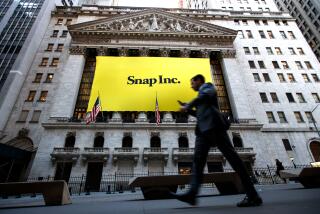Column: We told you the Snap IPO was a sucker’s bet, and its first quarterly report shows why
- Share via
In the teeth of the euphoria surrounding the Snap Inc. initial public offering last February, I warned that the IPO was a “sucker’s bet.”
That’s because its financial numbers looked ugly, with not much of a chance of a prettifying makeover. Furthermore, investors were committing their money to management by a 26-year-old CEO, Evan Speigel, with no experience running a public company or steering an enterprise through even a minor pothole.
Now Spiegel faces a major pothole: Snap’s results for the first quarter of 2017, its first earnings report as a public company, are awful. My colleague Paresh Dave reports that the company disclosed slowing user growth and average revenue per user, and a loss of $2.2 billion. As we write, its shares are taking a beating, down more than 23% to $17.61, a hair above the IPO price of $17.
Below is the column I wrote on Feb. 10, just before the IPO.
________________________________________
If you’re looking for an uplifting story in these troubled times, you need go no further than news about the coming initial public offering of stock in Snap Inc.
The social media company based out by Venice Beach, which allows users to exchange smartphone-snapped photos that are deleted after viewing, unveiled its S-1 registration statement with the Securities and Exchange Commission on Thursday. The move instantly inspired predictions that the IPO could generate $4 billion in capital, with a company valuation of $25 billion. As my colleagues Paresh Dave and James Rufus Koren report, this would be one of the biggest IPOs in U.S. history and the biggest ever for a Los Angeles company. Co-founders Evan Spiegel and Bobby Murphy, who serve, respectively, as chief executive and chief technology officer, are said to have conceived of the Snapchat app in their Stanford frat house, would almost certainly become billionaires on paper.
We ... may never achieve or maintain profitability.
— Single most important statement in Snap’s IPO filing
Investors supposedly are slavering to get in on the ground floor once the IPO actually happens a few weeks from now. We have a different view. Our advice to anyone expecting to make a mint from Snap is: Good luck, sucker.
Our rationale comes right out of the Snap filing, though the numbers get casually glossed over in the pro-Snap pre-IPO hysteria. The S-1 tells the goriest story of bloodletting this side of Shakespeare’s “Titus Andronicus.” (The complete filing is here.)
Let’s start with the bottom line: Snap, which gets all its money from advertising, is an enormous money loser. The red ink has been getting worse even as revenue grows. In 2015, Snap lost $373 million on revenue of $58.7 million. Last year, revenue mushroomed to $404.5 million, and losses grew to $514.6 million.
When these losses will end is anyone’s guess, including management. Among the risk factors listed in the filing is this: “We … may never achieve or maintain profitability.” Yes, these risk factors are often boilerplate, but the filing provides no justification for ignoring this one.
Another major drawback is that investors in Snap will be inextricably wed to Spiegel, 26, and Murphy, 28, who share 88.6% voting control of the company. They won’t give up an iota of that control in the IPO, since the shares being offered have zero voting power. That’s a lot of authority to place in the hands of two untested executives (especially Spiegel, who will be in day-to-day control), since their major demonstrated skill thus far has been to spend stupendous amounts of other people’s money.
The bull investor’s argument for Snap is that its customer base has been growing exponentially, reaching 158 million daily active users at the end of last year, and still has room for expansion, especially outside the country. Snap says that in the U.S., where the vast bulk of its users reside, advertisers fall over each other to gain access to this user population, which is overwhelmingly at millennial age or a bit older. Some 85% of Snapchat users are between13 and 34, and 58% are 24 or younger.
The investment crowd is obviously hoping that Snap will grow into profitability, like Facebook — another company whose founder and chairman, Mark Zuckerberg, maintains unassailable voting control. That could happen, certainly, but it’s a long shot. There’s just as much chance that Snap could look like Twitter, which collected $1.8 billion from its 2013 IPO at $26 a share, and has racked up more than $1.4 billion in losses since then. On Friday its shares were trading below $18. Snap calls itself a “camera company,” but the last company to stage an IPO as a purveyor of cameras for self-expression was GoPro, in 2014. GoPro eked out a small profit for a year or so after that, but it lost more than $400 million last year and it’s currently trading at less than half its IPO price.
What could go wrong with Snap? The real dangers are implicit in the user statistics. Most worrisome, Snap’s terrific rate of customer growth has slowed sharply. It served 46 million users in the first quarter of 2014 and nearly trebled to 122 million by the same quarter two years later. But Snap added only 5 million users in the fourth quarter of 2016, its lowest figure since mid-2014.
One could ascribe the slowdown to the difficulty of maintaining high percentage growth rates as the base gets larger, but something else happened that should raise an alarm: On Aug. 2, Instagram, which is owned by Facebook, introduced a clone of Snapchat’s “stories” function, which allows users to post their photos and videos to a page all their friends and contacts can see. Instagram has 600 million global users, and by some accounts Instagram Stories eviscerated Snapchat’s growth. The episode underscores a problem that Snap’s S-1 mentioned in passing — it faces “significant competition.” The bar to competition looks low, since nothing about Snap suggests that it has a lock on proprietary technology to fend off rivals.
It should be clear by now that Snap is the quintessential Wall Street “story stock.”
Much of the story involves Spiegel, who already has become shrouded within a miasma of breathless PR. He’s engaged to a Victoria’s Secret model! He’s only 26! He gets written up in GQ! He’s driven around in a black Range Rover and surrounded by security guards! He doesn’t tell anyone what he’s thinking! His hero is Steve Jobs!
Given the structure of voting control, investors should approach this situation warily. Spiegel’s experience as head of a business totals about five years. He hasn’t had to manage through a crisis or even a mild downturn. If he decides one day that Snap’s future lies in building a staircase to the moon, stockholders will have no option other than to sell, and they may have to scramble to get out ahead of the mob. There are indications that Spiegel and Murphy weren’t even the originators of the Snapchat idea — the S-1 reveals that in 2014 they agreed to pay $157.5 million to settle a claim by another fratmate, Reggie Brown, that they had stolen his idea.
It’s said that adult supervision will be provided at Snap by Michael Lynton, who has resigned as Sony Pictures Entertainment’s studio chief to become Snap’s chairman. Possibly Lynton was looking for a new and exciting arena to display his management skills. On the other hand, Sony just this week took a nearly $1-billion write-down on the movie business Lynton headed, so he might merely have been getting out of town one step ahead of the hangman.
Make no mistake, the Snap IPO will create millionaires and billionaires, at least at first and on paper. The early investors and venture firms will be able to cash in their millions of nonvoting Class A shares via the IPO. But what about the people who take these shares off their hands? For those lining up to be among them, we wouldn’t think of getting in their way. They should go in with their eyes wide, wide open, but given the developing frenzy, what are the chances of that?
Keep up to date with Michael Hiltzik. Follow @hiltzikm on Twitter, see his Facebook page, or email michael.hiltzik@latimes.com.
Return to Michael Hiltzik’s blog.
MORE FROM MICHAEL HILTZIK
Another casualty of Trump’s Muslim ban: U.S. medical training and rural healthcare
Citing GOP delay on replacement, Aetna signals full withdrawal from Obamacare in 2018







